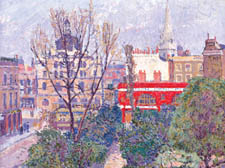|
|
 |
| |

Mornington Crescent (detail) by Spencer Gore |
Group that painted the town
The Camden Town Group captured the grit of the streets and made their work accessible to all, writes Gerald Isaaman
WALTER Sickert, of course, suggested the name for the Camden Town Group of 16 painters who changed modern art in Britain almost a century ago.
He said he wanted to acknowledge that the district had been “so watered with my tears that something important must sooner or later spring from this soil”.
When you see the magnificent comprehensive exhibition of the group’s manifestations at Tate Britain – the first critical survey for at least half a century – you begin to shed your own tears over why it takes so long to recognise and pay triumphant tribute to such native genius.
Chancellors may be accused of dithering but here is an example, thankfully at a time when the country sits miserably in sackcloth and ashes – due partly to a malevolent media – when we can shout triumphantly: “You’ve got it right at last.”
Although the artists, in general, came from middle-class backgrounds, they dug the dirt of the day in honestly depicting real life, their own grim and sunless world of crime and poverty, deprivation and debauchery in a rapidly changing world that, undoubtedly, has lingering, depressing effects.
Yet it is in the haunting, vernacular images of gloom and grit that these volatile painters of modern life, who used the charlady and the flower-seller as their naïve models, that is uplifting, making a mockery of the fashionable art of their day and leaving a legacy that is both profound and inspiring.
They were the painters of passion, outcasts who, inspired by the French impressionists, produced a truly kitchen-sink art depicting exactly what was going on in their own backyard, exposing the sins and senselessness of society with a poignant brutality that has a defining beauty all its own.
“I want (& this we can all understand and never say) to get together a milieu rich or poor, refined, even to some extent vulgar, which is interested in painting & in the things of the intelligence, & which has not an aggressively anti-moral attitude,” wrote Sickert. “To put it on the lowest grounds, it interferes with business.”
And it interfered not only in provoking sensation and reform, as, for example, they explored sexual attitudes alongside the literature of HG Wells and DH Lawrence, but in making their works cheap and available to anyone. If nothing else, the artists were a collective, interested in earning a living by finding new ways of selling their work outside of the established galleries.
You will find yourself on familiar ground as you view the local street scenes of Camden Town and Piccadilly as the Tube, the railway and bustling red buses changed social mobility, and you will be able to discover the numerous studio and bedsitter addresses from which the artists worked with such sincerity and dedication.
The names, in particular Spencer Gore, Charles Ginner, Harold Gilman, Robert Bevan and Malcolm Drummond, have equally earned their own distinctions as they thrust themselves into the shops, streets, factories and dark alleyways of Camden Town, the Old Bedford Music Hall, too, where seats cost but three shillings and sixpence but where the locals were ripped off with over-priced booze and food.
Three heroes emerge for me – Sickert, who was in a class of his own as he sought to discover “colour in the shadows”, and use his art, especially when it comes to prostitution and murder, as a challenge for social change. Then there is the duo of Harold Gilman and Charles Ginner, whose humanity transformed the shabby ordinariness of their environment and the limited people who endured it. |

|
 |
|
 |
|

